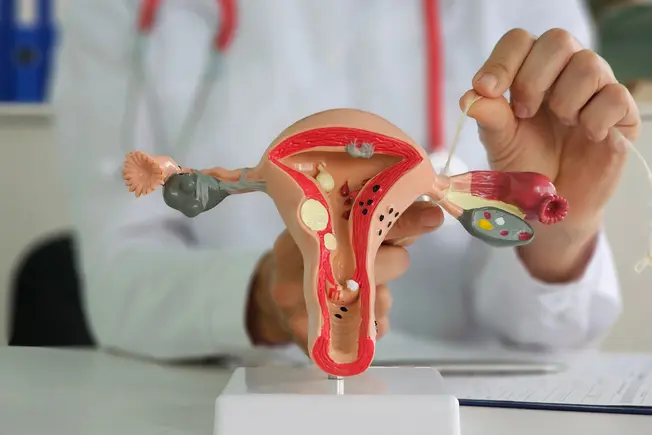- Overview
- Types
- Hormonal Methods
- Barrier Methods
- Behavioral Methods
- Medical Methods
- Male Birth Control
- Emergency Contraception
- Side Effects & Complications
- View Full Guide
Understanding Tubal Ligation


Understanding Tubal Ligation
Tubal ligation, sometimes called "having your tubes tied," is a permanent birth control method. You have surgery to cut or block your fallopian tubes. That way, the eggs released by your ovary can't be fertilized by sperm.

Effectiveness of Tubal Ligation
It's one of the most reliable birth control methods. Only about 1 in 200 of those who've had a tubal ligation get pregnant. That's less than 1%.

Is It Reversible?
Tubal ligation can sometimes be reversed. But reversal doesn't always work, so it's important to think carefully about whether you want to go ahead with the procedure.

Pros of Tubal Ligation
Tubal ligation is a permanent and highly effective birth control method that doesn't affect your hormone levels. It can be a good option if you don't want to have children or you don't wish to have any more.

Cons to Consider
Reversal can be difficult and not always successful. There is also a risk of ectopic pregnancy, where a fertilized egg implants outside the uterus.

Recovery Time
Recovery varies depending on the type of procedure. Laparoscopic tubal ligation typically has a shorter recovery period compared to laparotomy.

What It Costs?
The cost in the U.S. ranges from $0 to $5,000 or higher, depending on insurance coverage, location, and type of procedure. One benefit is that you won't have to pay for other types of birth control.

Other Birth Control Methods
Other options include barrier methods such as condoms or diaphragm, hormonal options such as pills and patches, IUDs, implants, and vasectomy for men.
Photo Credits:
1) NMK-Studio/Shutterstock
2) Prostock-studio/Shutterstock
3) Yuri A/Shutterstock
4) luchschenF/Shutterstock
5) Ground Picture/Shutterstock
6) Josep Suria/Shutterstock
7) Kmpzzz/Shutterstock
8) Pixel-Shot/Shutterstock
SOURCES:
Johns Hopkins Medicine: “Salpingectomy,” “Tubal Ligation.”
Mayo Clinic: “Tubal Ligation,” “Tubal Ligation Decreases Risk of Developing Ovarian Cancer,” “Ectopic Pregnancy,” “Ovarian Cancer,” “ParaGard,” “Contraceptive implant.”
University of Florida Health: “Tubal Ligation,” “Birth Control Pills -- An Overview,” “Deciding About an IUD.”
The American College of Obstetricians and Gynecologists: “Postpartum Sterilization,” “Sterilization for Women and Men,” “Ectopic Pregnancy,” “Sterilization by Laparoscopy,” “Long-Acting Reversible Contraception: Intrauterine Device and Implant,” “Opportunistic Salpingectomy as a Strategy for Epithelial Ovarian Cancer Prevention,” “Barrier Methods of Birth Control: Spermicide, Condom, Sponge, Diaphragm, and Cervical Cap.”
Journal of Women’s Health: “Comparison of Healthcare Costs Among Commercially Insured Women in the United States Who Underwent Hysteroscopic Sterilization Versus Laparoscopic Bilateral Tubal Ligation Sterilization.”
Hillis, S.D. Obstetrics and Gynecology, December 1999.
Urology Care Foundation: “What is a Vasectomy?”
American Cancer Society: “Can Ovarian Cancer Be Prevented?”
Coalition for Post Tubal Women: “Post Tubal Ligation Syndrome (PTLS).”
FDA: “Condoms and Sexually Transmitted Diseases.”
Cleveland Clinic: “Tubal Reversal,” “Tubal Ligation,” "“Intrauterine Device (IUD).”
Ryoikibetsu Shokogun Shirizu: “Post-tubal ligation syndrome.”
New England Journal of Medicine: “The risk of menstrual abnormalities after tubal sterilization.”
StatPearls: “Tubal ligation.”
U.S. Department of Health and Human Services: “Female Sterilization Fact Sheet.”
Wisconsin Department of Health Services: “Family Planning Only Services Program.”
University of Wisconsin Health: “Tubal Ligation Reversal.”
Kaiser Family Foundation: “Sterilization as a Family Planning Method” “Medicaid Coverage of Family Planning Benefits: Findings from a 2021 State Survey.”
CDC: “Contraception,” “Barrier Methods of Birth Control: Spermicide, Condom, Sponge, Diaphragm, and Cervical Cap.”
Yale Medicine: “Intrauterine Devices (IUDs): What Women Need to Know.”
Florida Health Bay County: “Sterilization Eligibility.”
National Women’s Law Center: “Tips From the CoverHer Hotline: Navigating Coverage for Tubal Ligation and Bilateral Salpingetomy.”
United Nations University: “Health Consequences of Sterilization.”
British Journal of Cancer: “Tubal ligation in relation to menopausal symptoms and breast cancer risk.”
Fertility and Sterility: “Complications of female sterilization: immediate and delayed.”
Contemporary OB/GYN/OBGyn.net conference coverage: “Post-Tubal Ligation Pain.”
Society to Improve Diagnosis in Medicine: “Feeling Dismissed and Ignored by Your Doctor? Do This.”
American Journal of Obstetrics & Gynecology: “Salpingectomy vs. Tubal Ligation for Sterilization: A Systematic Review and Meta-Analysis.”
Bedsider: “Sterilization.”
Fertility and Sterility: “Comparative Effectiveness of Hysteroscopic and Laparoscopic Sterilization for Women: A Retrospective Cohort Study.”
Journal of Family Medicine and Primary Care: “Comparative Study on Menstrual Disorders in Post-Tubal Ligated and Non-Ligated Women.”
National Health Service: “Afterwards - Miscarriage,” “Essure Contraception Device.”
Obstetrics & Gynecology: “Patient-Centered Safety Outcomes After Hysteroscopic Compared with Laparoscopic Sterilization.”
Up To Date: “Hysteroscopic Female Permanent Contraception,” “Patient Education: Permanent Birth Control for Women (Beyond the Basics).”